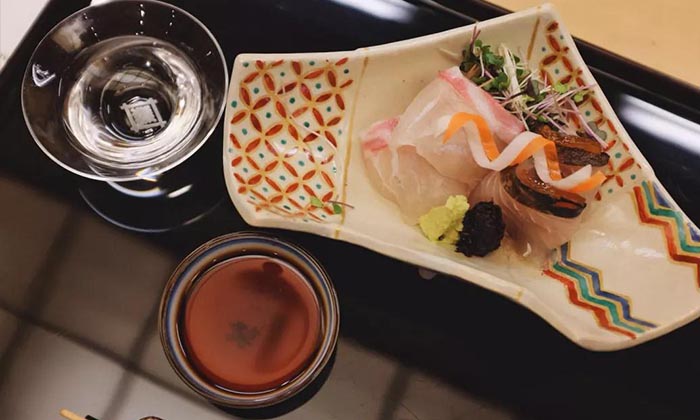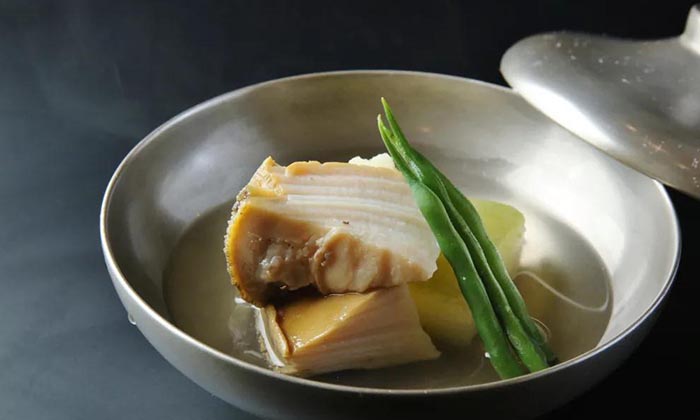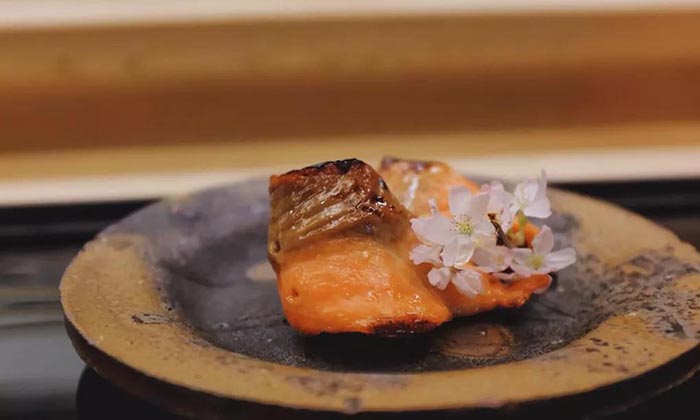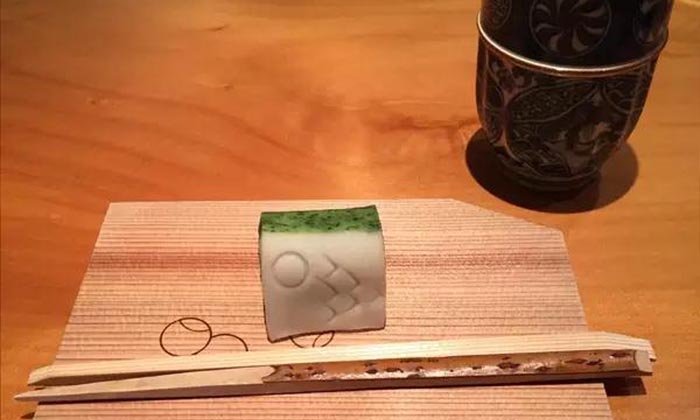Japan Kaiseki Cuisine
Japanese cuisine is one of the world-renowned foods, and no Japanese cooking technique performs better than Kaiseki Ryori's dishes. Kaiseki originates in temples and monks who strictly followed the rules on only eating twice a day and fasted. During the long fasting period, you warm your stomach with a warm stone. Kaiseki Ryori is also the oldest cuisine in Japan, which has been around for about 450 years. With the passage of a century, Kaiseki Ryori has now become the pinnacle of fine Japanese cuisine and has become the most expensive gourmet cuisine in Japan.
Kaiseki Ryori has very strict rules and is the earliest and most orthodox cooking system in Japanese cuisine. Among them, Kaiseki Ryori's biggest feature is the use of fresh seasonal ingredients, no coloring of sauces, as much as possible to maintain the original appearance and color of the food, focusing on expressing the taste of the food itself to awe nature. The ingredients are also extremely delicate so that the fish doesn't have a thorn, and the amount of vegetables is precisely controlled. SO Kaiseki Ryori, who has more than a dozen dishes, looks very small in each dish, but after a feast, all the food can be enjoyed, and the food is never wasted. It is also one of the philosophies of Japanese cuisine.

Sakizuke is an appetizer that is lightly seasoned and fresh in texture. It is made using the freshest ingredients of the season. Based on the principle of low-key luxury, only one or two cherished ingredients are used to highlight the nobleness of Kaiseki cuisine.
Hassun, a season-themed dish, is usually a combination of sushi and several smaller dishes and is the official appetizer of the whole course. Hassun is served as a libation, sometimes as an appetizer, and sometimes at the end, as a conclusion. Its significance is to combine delicious seasonal dishes with a plate.
Mukōzuke, which is what we call the head dish, serves as the first dish, and more seasonal sashimi is used. Sashimi is the proudest way of cooking in Japan, and the doorway is far deeper than expected. Fresh fish is the basic requirement for sashimi. Season origin, fishing treatment, knife method, and seasoning are the key to the deliciousness of sashimi. Bream and catfish in the spring, catfish in the summer, tuna in the autumn, and pufferfish in the winter are all high-end ingredients that Mukōzuke specializes in. It is worth mentioning that having wasabi with raw fish has something particular about it. Good wasabi is mainly sweet and has a spicy taste which makes it just right. It is thinly applied to the fillets and has a fresh and smooth texture.
Futamono is a portion of food served in a lacquered bowl with a lid, usually steamed in soup or tea bowl. Common Futamono ingredients in the spring include snapper, oilfish, wormwood, and tofu. Fish minced in the summer, matsutake in the autumn, and crabs in the winter are common Futamono ingredients in the different seasons.

Yakimono is a seasonal fish barbecue in Kaiseki Ryori. In Japanese materials, ingredients, especially the types of catches, are graded. Ordinary salmon is almost impossible to reach the table of the high-level Japanese restaurant. In high-quality Kaiseki Ryori restaurant, Sakura trout is the most common Yakimono ingredient in the spring. It is better to eat swordfish in the summer, and seasonal fish with seeds in the autumn, and in the winter is the pufferfish with barbeque.
Naka-choko refers to snacks served with wine during meals. The taste is mainly acidic. Baizi has always been one of the high-end ingredients prepared by Kaiseki. The sea bream Baizi in the spring and the pufferfish Baizi in the winter are both worth trying.
Shii-zakana is the main course of Kaiseki Ryori; it is usually roasted or steamed beef, poultry, fish, etc. Shii-zakana for hot pot stew is usually changed to grilled or steamed dishes. In the winter, pufferfish hot pot is a must-try classic.
Gohan, rice-based staple food is served with Kou no mono and Tome-wan. Kou no mono is a Japanese pickle, and TOme-wan is a soup that goes with a meal. Bamboo shoots are the absolute top brand of Gohan in the spring and the summer, lotus root, taro, plum, catfish, and ayu can be eaten. During the fall, the matsutake-style rice is popular, and in the winter, the dish is mainly made of tofu, radish, and other warm ingredients.
Mizumono is a dessert that is made of fruits such as honeydew melon, peach, and other high-end fruits. It can also be a traditional Japanese dessert.

Kaiseki Ryori's dishes and utensils are also full of different elements of each season. In addition to the embellishments of the spring cherry blossoms and autumn maple leaves, cups and bowls can be used alternately with the season. In some top kiosks, ordinary tableware can reach tens of thousands of yen. However, the delicate and expensive tableware will never appear a second time in the same meal, which shows respect for their food and guests.
If you visit Japan in person, you will find a word that is closely related to Kaiseki Ryori, which is Kyoto Kaiseki Ryori. This includes a lot of Kyoto's characteristics, such as the use of Kyoto's vegetables, noodles, tofu, fully reflected in cooking, Kyoto's eating habits and cooking methods. In fact, Kyoto is not the origin of Kaiseki Ryori, but it is a place to cultivate Kaiseki Ryori, which has a deep Kaiseki Ryori heritage. First of all, Kyoto was the capital of Japan, and it was inhabited by dignitaries. Tea parties and banquets were often held between them, so they created opportunities for the development of Kaiseki Ryori.
In addition, Kyoto is rich in natural resources, and the use of ingredients is flexible and diverse. Furthermore, the Kyoto locals have always attached great importance to traditional things, so that the Kaiseki Ryori can inherit and develop well. So Kyoto deserves to be the hometown of Kaiseki Ryori and has also become the signboard of Kyoto. Therefore, if you want to taste authentic Kaiseki Ryori, you should choose the traditional and old restaurants in Kyoto. There are countless Kaiseki Ryori restaurants located in Kyoto. You should come to Kyoto and experience the subtle flavor with a simple and elegant meal.

Address: 35 Nanzenji Kusakawacho, Sakyo Ward, Kyoto
Yoshio Kyoto Kitcho Arashiyama
Kyoto's old kaiseki restaurant, Samsung Michelin, is located on the road from Arashiyama to Togetsukyo.
Address: 58 Sagatenryuji Susukinobabacho, Ukyo Ward, Kyoto
Kikunoi
Kikunoi Honten was founded in 1912 and is located in Kyoto, a famous Michelin restaurant.
Address: Kyoto, Higashiyama Ward, Shimokawaracho, 459

As a travel agency in Japan, we offer Japan small group tours and chauffeur service for tourist from overseas, if you want to try and experience the Kaiseki cuisine during your trip in Japan, please feel free to contact our specialists.
Japanese cuisine is one of the world-renowned foods, and no Japanese cooking technique performs better than Kaiseki Ryori's dishes. Kaiseki originates in temples and monks who strictly followed the rules on only eating twice a day and fasted. During the long fasting period, you warm your stomach with a warm stone. Kaiseki Ryori is also the oldest cuisine in Japan, which has been around for about 450 years. With the passage of a century, Kaiseki Ryori has now become the pinnacle of fine Japanese cuisine and has become the most expensive gourmet cuisine in Japan.
Kaiseki Ryori has very strict rules and is the earliest and most orthodox cooking system in Japanese cuisine. Among them, Kaiseki Ryori's biggest feature is the use of fresh seasonal ingredients, no coloring of sauces, as much as possible to maintain the original appearance and color of the food, focusing on expressing the taste of the food itself to awe nature. The ingredients are also extremely delicate so that the fish doesn't have a thorn, and the amount of vegetables is precisely controlled. SO Kaiseki Ryori, who has more than a dozen dishes, looks very small in each dish, but after a feast, all the food can be enjoyed, and the food is never wasted. It is also one of the philosophies of Japanese cuisine.

Recommended Kaiseki in Japan
Kaiseki Ryori can be complicated or simple, usually starting with the pre-dinner dishes of Sakizuke, Hassun, to Mukōzuke, Futamono, Takimono, step by step to the peak of the best taste experience, then the clearing of the Gohan, Kou no mono, etc, and finally with Mizumono Seasonal dessert ends with a meal. Different restaurants will slightly adjust the menu at different seasons, and the number of servings may be different. Some "one juice and three dishes" may have dozens of high specifications.Sakizuke is an appetizer that is lightly seasoned and fresh in texture. It is made using the freshest ingredients of the season. Based on the principle of low-key luxury, only one or two cherished ingredients are used to highlight the nobleness of Kaiseki cuisine.
Hassun, a season-themed dish, is usually a combination of sushi and several smaller dishes and is the official appetizer of the whole course. Hassun is served as a libation, sometimes as an appetizer, and sometimes at the end, as a conclusion. Its significance is to combine delicious seasonal dishes with a plate.
Mukōzuke, which is what we call the head dish, serves as the first dish, and more seasonal sashimi is used. Sashimi is the proudest way of cooking in Japan, and the doorway is far deeper than expected. Fresh fish is the basic requirement for sashimi. Season origin, fishing treatment, knife method, and seasoning are the key to the deliciousness of sashimi. Bream and catfish in the spring, catfish in the summer, tuna in the autumn, and pufferfish in the winter are all high-end ingredients that Mukōzuke specializes in. It is worth mentioning that having wasabi with raw fish has something particular about it. Good wasabi is mainly sweet and has a spicy taste which makes it just right. It is thinly applied to the fillets and has a fresh and smooth texture.
Futamono is a portion of food served in a lacquered bowl with a lid, usually steamed in soup or tea bowl. Common Futamono ingredients in the spring include snapper, oilfish, wormwood, and tofu. Fish minced in the summer, matsutake in the autumn, and crabs in the winter are common Futamono ingredients in the different seasons.

Yakimono is a seasonal fish barbecue in Kaiseki Ryori. In Japanese materials, ingredients, especially the types of catches, are graded. Ordinary salmon is almost impossible to reach the table of the high-level Japanese restaurant. In high-quality Kaiseki Ryori restaurant, Sakura trout is the most common Yakimono ingredient in the spring. It is better to eat swordfish in the summer, and seasonal fish with seeds in the autumn, and in the winter is the pufferfish with barbeque.
Naka-choko refers to snacks served with wine during meals. The taste is mainly acidic. Baizi has always been one of the high-end ingredients prepared by Kaiseki. The sea bream Baizi in the spring and the pufferfish Baizi in the winter are both worth trying.
Shii-zakana is the main course of Kaiseki Ryori; it is usually roasted or steamed beef, poultry, fish, etc. Shii-zakana for hot pot stew is usually changed to grilled or steamed dishes. In the winter, pufferfish hot pot is a must-try classic.
Gohan, rice-based staple food is served with Kou no mono and Tome-wan. Kou no mono is a Japanese pickle, and TOme-wan is a soup that goes with a meal. Bamboo shoots are the absolute top brand of Gohan in the spring and the summer, lotus root, taro, plum, catfish, and ayu can be eaten. During the fall, the matsutake-style rice is popular, and in the winter, the dish is mainly made of tofu, radish, and other warm ingredients.
Mizumono is a dessert that is made of fruits such as honeydew melon, peach, and other high-end fruits. It can also be a traditional Japanese dessert.

Kaiseki Ryori's dishes and utensils are also full of different elements of each season. In addition to the embellishments of the spring cherry blossoms and autumn maple leaves, cups and bowls can be used alternately with the season. In some top kiosks, ordinary tableware can reach tens of thousands of yen. However, the delicate and expensive tableware will never appear a second time in the same meal, which shows respect for their food and guests.
If you visit Japan in person, you will find a word that is closely related to Kaiseki Ryori, which is Kyoto Kaiseki Ryori. This includes a lot of Kyoto's characteristics, such as the use of Kyoto's vegetables, noodles, tofu, fully reflected in cooking, Kyoto's eating habits and cooking methods. In fact, Kyoto is not the origin of Kaiseki Ryori, but it is a place to cultivate Kaiseki Ryori, which has a deep Kaiseki Ryori heritage. First of all, Kyoto was the capital of Japan, and it was inhabited by dignitaries. Tea parties and banquets were often held between them, so they created opportunities for the development of Kaiseki Ryori.
In addition, Kyoto is rich in natural resources, and the use of ingredients is flexible and diverse. Furthermore, the Kyoto locals have always attached great importance to traditional things, so that the Kaiseki Ryori can inherit and develop well. So Kyoto deserves to be the hometown of Kaiseki Ryori and has also become the signboard of Kyoto. Therefore, if you want to taste authentic Kaiseki Ryori, you should choose the traditional and old restaurants in Kyoto. There are countless Kaiseki Ryori restaurants located in Kyoto. You should come to Kyoto and experience the subtle flavor with a simple and elegant meal.

Recommended Kaiseki in Kyoto
Hyotei is a three-star Michelin restaurant with a long history and its style is closer to the essence of traditional kaiseki.Address: 35 Nanzenji Kusakawacho, Sakyo Ward, Kyoto
Yoshio Kyoto Kitcho Arashiyama
Kyoto's old kaiseki restaurant, Samsung Michelin, is located on the road from Arashiyama to Togetsukyo.
Address: 58 Sagatenryuji Susukinobabacho, Ukyo Ward, Kyoto
Kikunoi
Kikunoi Honten was founded in 1912 and is located in Kyoto, a famous Michelin restaurant.
Address: Kyoto, Higashiyama Ward, Shimokawaracho, 459

As a travel agency in Japan, we offer Japan small group tours and chauffeur service for tourist from overseas, if you want to try and experience the Kaiseki cuisine during your trip in Japan, please feel free to contact our specialists.
Related Articles You May Like
Most Frequently Asked Questions
-
What dishes does Kaiseki Ryori in Japan have?Kaiseki Ryori can be complicated or simple, and there are one juice and three dishes, and the specificatoins may be dozens. Usually you start with the pre-dinner dishes of Sakizuke and Hassun, and then move onto the Mukozuke, Futamono, Yakimono, and take it step by step to get a better taste experience. Once those dishes have been cleared with Goahn, Lou no mono, etc, the finally end the meal with seasonal desserts of Mizumono.
-
Why is Kaiseki Ryori in Japan called "Kei Kaiseki"?Since Kyoto was the capital of Japan and lived in the Daguan aristocracy, banquets are often held here, so Kaiseki Ryori has developed well in Kyoto. Furthermore, the Kyoto people pay attention to the traditional things, which makes Kaiseki Ryori inherit and develop well. So Kyoto deservedly become the "hometown" of Kaiseki Ryori.
-
Which Kaiseki Ryori shops are available in Kyoto, Japan?Hyotei is a three-star Michelin restaurant with a long history and its style is closer to the essence of traditional kaiseki. Kyoto Kitcho Arashiyama is an old-fashioned kaiseki restaurant in Kyoto, three Michelin stars, located on the road from Arashiyama to Togetsubashi. Kikunoi Honten was founded in 1912 and is located in Kyoto, a famous Michelin restaurant.
-
Where is Kikunoi, a Kaiseki Ryori restaurant in Kyoto, Japan?Kikunoi's head office is located in Kyoto at Kigashiyama Ward, Shimokawaracho 459. According to legend, Toyotomi Hideyoshi's first wife used the well water to make tea and the water emerging from the well was like a blooming chrysanthemum. Therefore, the grandparents of Kikunoi took great care of this well, and later used the well's water to cook. Kukunoi is named after this well.
-
Where is Hyotei, a Kaiseki Ryori restaurant located in Kyoto, Japan?With a history of 400 years, Hyotei was the first tea house to make tea for people visiting the Nanzen Temple, but it gradually evolved into a super-class kiosk until it reached the three Michelin stars. The address is 35 Nanzenji Kusakawacho, Sakyo Ward, Kyoto.
-
Where is Kyoto Kitcho Arashiyama located in Kyoto, Japan?The address is 58 Sagatenryuji Susukinobabacho, Ukyo Ward, Kyoto. The first Kitcho opened in Osaka in 1930, and after decades of development, Kitcho has continued to grow and our store has moved from Osaka to Arashiyama, Kyoto. Kitcho is not only authentic Kaiseki Ryori, but also extremely sophisticated in utensils, and won the Michelin crown.
-
Is there a Kaiseki Ryori restaurant near Shimagamo Jinja in Kyoto, Japan?It is recommended to go to the Kichisen Kyoto, Samsung Michelin store. The location is next to the park where Shimogamo Jinja is located. The address is Kyoto, Sakyo Ward, Shimogamo Morimotocho 5. The dishes are prepared according to the best ingredients during the different seasons.
Japan Office
- Tel: +81 50-3701-6391
- Email: info@japanholiday.com
- Working Hours: 8am-7pm, (Japan)
USA Office
- Tel: +1-6265617117
- Email: info@japanholiday.com
- Working Hours: 8am-7pm, Pacific Time

